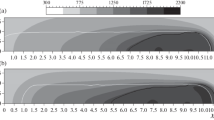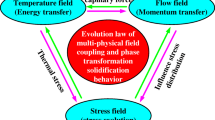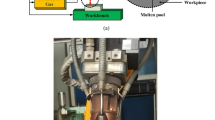Abstract
A comprehensive methodology for the implementation of thermal convection into the finite element (FE) analysis of laser direct energy deposition (DED) cladding is developed and validated. Improved convection modeling will produce improved thermal simulations, which will in turn yield more accurate results from subsequent models seeking to predict microstructural changes, deformation, or residual stresses. Two common convection implementations, considering no convection or free convection only, are compared to three novel forced convection methods: forced convection from heat transfer literature, forced convection from lumped capacitance experiments, and forced convection from hot-film anemometry measurements. During the cladding process, the exposed surface, the surface roughness, and total surface area change due to material deposition. The necessity of accounting for the evolution of the mesh surface in the FE convection model is investigated. Quantified error analysis shows that using any of the three forced convection methodologies improves the accuracy of the numerical simulations. Using surface-dependent hot-film anemometry measured convection yields the most accurate temperature history, with L 2 norm errors of 6.25−22.1 ∘C and time-averaged percent errors of 2.80–12.4 %. Using a physically representative convection model applied to a continually evolving mesh surface is shown to be necessary for accuracy in the FE simulation of laser cladding processes.
Similar content being viewed by others
References
Griffith ML, Keicher DM, Atwood CL, Romero JA, Smugeresky JE, Harwell LD, Greene DL (1996) Free form fabrication of metallic components using laser engineered net shaping (lens). In: P. Solid Freeform Fab. Symp.s, volume 9, pages 125–131. The University of Texas at Austin
Mazumder J, Choi J, Nagarathnam K, Koch J, Hetzner D (1997) The direct metal deposition of h13 tool steel for 3-d components. Jom-J Min Met Mat S 49(5):55–60
Griffith ML, Schlienger ME, Harwell LD, Oliver MS, Baldwin MD, Ensz MT, Essien M, Brooks J, Robino CV, Smugeresky JE, Wert MJ, Nelson DV (1999) Understanding thermal behavior in the lens process. Mater Design 20(2):107–113
Xue L, Islam MU (2000) Free-form laser consolidation for producing metallurgically sound and functional components. J Laser Appl 12:160
Dinda GP, Dasgupta AK, Mazumder J (2009) Laser aided direct metal deposition of inconel 625 superalloy: Microstructural evolution and thermal stability. Mat Sci Eng A 509(1):98–104
Rombouts M, Maes G, Mertens M, Hendrix W (2012) Laser metal deposition of inconel 625: Microstructure and mechanical properties. J Laser Appl 24(5):052007
Ueda Y, Yamakawa T (1971) Analysis of thermal elastic-plastic stress and strain during welding by finite element method. Trans Jpn Weld Soc 2(2):186–196
Ueda Y, Takahashi E, Fukuda K, Sakamoto K, Nakcho K (1976) Multipass welding stresses in very thick plates and their annealing, reduction from stress relief. Trans Jpn Weld Res Inst 5(2):179–189
Rybicki EF, Shadley JR A three-dimensional finite element evaluation of a destructive experimental method for determining through-thickness residual stresses in girth welded pipes. J Eng Mater Technol.;(United States) 108(2):1986
Rybicki EF, Stonesifer RB (1979) Computation of residual stresses due to multipass welds in piping systems. J Press Vessel Tech 101(2):149–154
Feng Z, Wang XL, Spooner S, Goodwin GM, Maziasz PJ, Hubbard CR, Zacharia T (1996) A finite element model for residual stress in repair welds.Technical report, Oak Ridge National Lab.,TN (United States)
Michaleris P, DeBiccari A (1997) Prediction of welding distortion. Weld J Res Suppl 76(4):172s
Lindgren LE, Runnemalm H, Nom MO (1999) Simulation of multipass welding of a thick plate. Int J Numer Meth Eng 44(9):1301–1316
Anca A, Fachinotti VD, Escobar-Palafox G, Cardona A (2011) Computational modelling of shaped metal deposition. Int J Numer Meth Eng 85(1):84–106
Hoadley AFA, Rappaz M, Zimmermann M (1991) Heat-flow simulation of laser remelting with experimenting validation. Metall Trans B 22(1):101–109
Hoadley AFA, Rappaz M (1992) A thermal model of laser cladding by powder injection. Metall Trans B 23(5):631–642
Chin RK, Beuth JL, Amon CH (1996) Thermomechanical modeling of molten metal droplet solidification applied to layered manufacturing. Mech Mater 24(4):257–271
Han L, Phatak KM, Liou FW (2004) Modeling of laser cladding with powder injection. Metall Trans B 35(6):1139–1150
Pinkerton AJ, Li L (2004) An analytical model of energy distribution in laser direct metal deposition. Proc Inst Mech Eng B J Eng Manuf.e 218(4):363–374
Ahsan MN, Pinkerton AJ (2011) An analytical—Numerical model of laser direct metal deposition track and microstructure formation. Model Simul Mater Sc 19(5):055003
Bontha S, Klingbeil NW, Kobryn PA, Fraser HL (2006) Thermal process maps for predicting solidification microstructure in laser fabrication of thin-wall structures. J Mater Proces Tech 178(1):135–142
Aggarangsi P, Beuth JL, Griffith ML (2003) Melt pool size and stress control for laser-based deposition near a free edge. In P. Solid Freeform Fab. Symp.s, pages 196–207. University of Texas, Austin, TX
Han L, Phatak KM, Liou FW (2005) Modeling of laser deposition and repair process. J Laser Appl 17(2):89–99
Cooper D, Jackson DC, Launder BE, Liao GX (1993) Impinging jet studies for turbulence model assessment i. flow-field experiments. J Heat Trans T ASME 36(10):2675–2684
Craft TJ, Graham LJW, Launder BE (1993) Impinging jet studies for turbulence model assessment ii. an examination of the performance of four turbulence models. J Heat Trans T ASME 36(10):2685–2697
Behnia M, Parneix S, Durbin PA (1998) Prediction of heat transfer in an axisymmetric turbulent jet impinging on a flat plate. J Heat Trans T ASME 41(12):1845–1855
Merci B, Dick E (2003) Heat transfer predictions with a cubic model for axisymmetric turbulent jets impinging onto a flat plate. J Heat Trans T ASME 46(3):469–480
Gauntner JW, Livingood J, Hrycak P (1970) Survey of literature on flow characteristics of a single turbulent jet impinging on a flat plate. Washington, DC
Livingood JNB, Hrycak P (1973) Impingement heat transfer from turbulent air jets to flat plates: a literature survey
de Deus AM, Mazumder J (1996) Two-dimensional thermo-mechanical finite element model for laser cladding. In: Proceedings ICALEO, vol 1996, pp 174–183
Vasinonta A, Beuth JL, Griffith M (2007) Process maps for predicting residual stress and melt pool size in the laser-based fabrication of thin-walled structures. J Manuf Sci E.-T. ASME 129(1):101–109
Dai K, Shaw L (2002) Distortion minimization of laser-processed components through control of laser scanning patterns. Rapid Prototyping J 8(5):270–276
Wen S, Shin YC (2010) Modeling of transport phenomena during the coaxial laser direct deposition process. J Appl Phys 108(4):044908–044908
Wen S, Shin YC (2011) Comprehensive predictive modeling and parametric analysis of multitrack direct laser deposition processes. J Laser Appl 23(2):022003
Ghosh S, Choi J (2005) Three-dimensional transient finite element analysis for residual stresses in the laser aided direct metal/material deposition process. J Laser Appl 17(3):144–158
Ghosh S, Choi J (2006) Modeling and experimental verification of transient/residual stresses and microstructure formation in multi-layer laser aided dmd process. J Heat Trans -T ASME 128(7):662
Zekovic S, Dwivedi R, Kovacevic R (2005) Thermo-structural finite element analysis of direct laser metal deposited thin-walled structures. In: P. Solid Freeform Fab. Symp.s. University of Texas, Austin, TX, pp 338–355
Special Metals (2006) Inconel alloy 625. Technical Report Publication Number SMC-063
Goldak J, Chakravarti A, Bibby M (1984) A new finite element model for welding heat sources. Metall Trans B 15(2):299–305
Goldak J, Bibby M, Moore J, House R, Patel B (1986) Computer modeling of heat flow in welds. Metall Trans B 17(3):587–600
Hojny M Thermo-mechanical model of a tig welding process for the aircraft industry. Arch Metall Mat 58(4):2013
Wang L, Felicelli S (2006) Analysis of thermal phenomena in lens deposition. Mat Sci Eng A 435:625–631
Omega Engineering Inc (1998) Non-contact temperature measurement vol 1 2nd ed.Technical Report Transactions Vol 1
Omega Engineering Inc (2005) Revised thermocouple reference tables. Technical Report Publication Number z204–206
Michaleris P (2014) Modeling metal deposition in heat transfer analyses of additive manufacturing processes. Finite Elem Anal Des 86:51–60
Goodell WV, Coulter JK, Johnson PB (1973) Optical constants of inconel alloy films. JOSA 63(2):185–188
Heigel J (2014) Unpublished research. Technical report
Saad NR, Douglas WJM, Mujumdar AS (1977) Prediction of heat transfer under an axisymmetric laminar impinging jet. Ind Eng Chem Fund 16(1):148–154
Vorburger TV (1992) Methods for characterizing surface topography. Tutorials in Optics
Author information
Authors and Affiliations
Corresponding author
Rights and permissions
About this article
Cite this article
Gouge, M.F., Heigel, J.C., Michaleris, P. et al. Modeling forced convection in the thermal simulation of laser cladding processes. Int J Adv Manuf Technol 79, 307–320 (2015). https://doi.org/10.1007/s00170-015-6831-x
Received:
Accepted:
Published:
Issue Date:
DOI: https://doi.org/10.1007/s00170-015-6831-x




